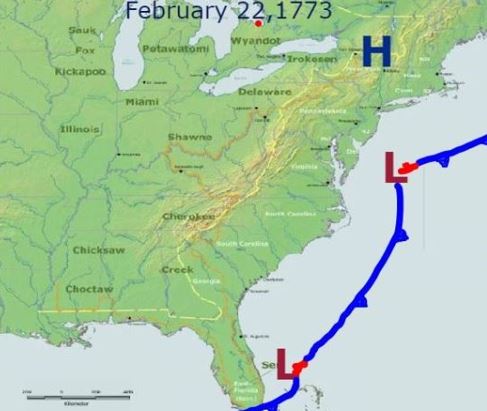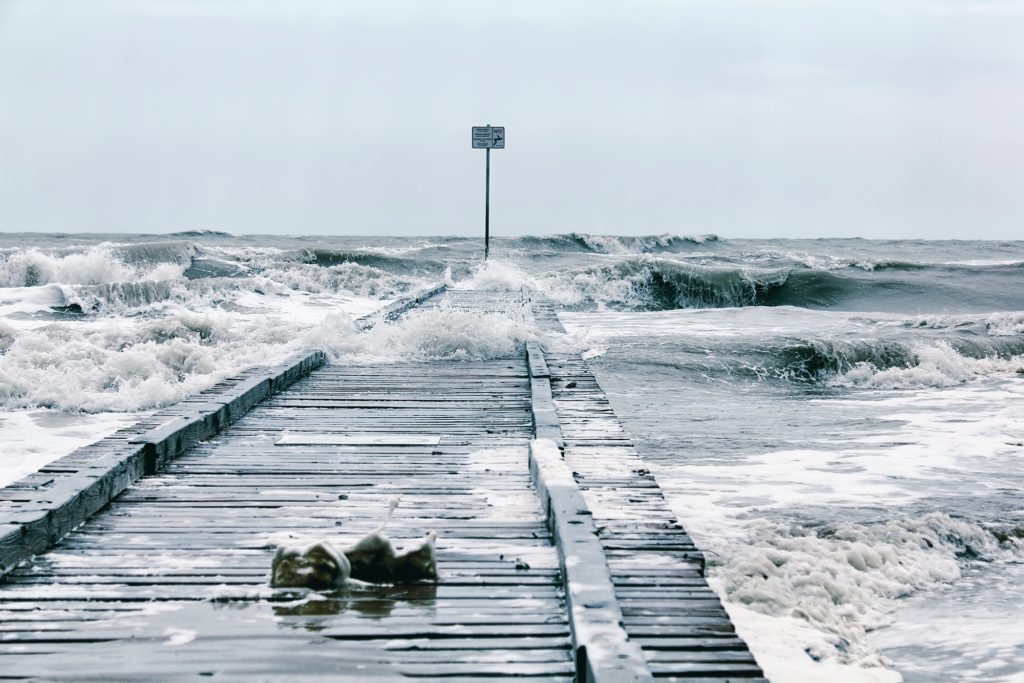There was an extremely cold period for the American Colonies in February of 1773. On several websites such as weatherforyou.com, they show notable weather events for a certain date. When I searched for February 22nd, this is what I saw – 1773 – The memorable “Cold Sabbath” in New England history. Many people froze their extremities while going to church. (David Ludlum).
That seemed interesting, but could I make a whole article out of it (with such scant information)?
Even though I did find more information about that event, it wasn’t enough to create a whole article. Perhaps I could find more information about the weather in other locations during that period of time. Well, it turns out that I did, and hopefully it will be interesting to you, the reader.
For those who have read any of my articles in the past, there are times when I have a bit of fun and look for historical weather events and I gather information, I try to recreate weather conditions for that date (in weather map form) even if the event occurred centuries ago. One of my favorite endeavors was to create a weather map based on conditions, indicated by Thomas Jefferson, and others, for July 4, 1996. I wrote that article for weather.com several years ago they post it every year on that date.
In this case, I was able to find more weather information, not only for New England but also down the Eastern Seaboard. My information is very spotty, to say the least. I made an attempt to recreate conditions but with low confidence. If there are any meteorologists who read this and have any suggestions or additions (or have their own ideas) please add them. So, this article is “interactive”. Here we go!
Weather Conditions – February 21-22, 1773
New England
One thing that we do know is that weather historian, David Ludlum identified “The Cold Sabbath”. Actually, the Sabbath was Sunday, February 21st. Church worshipers suffered frozen extremities (I would say frostbite) while making their way back and forth to church on that day.
So, How cold was it? David Lunum provides some good information in his book “The Weather Factor“. A bitterly cold air mass came in on February 20th. On Sunday, the temperature at Portsmouth, New Hampshire dropped to 20 degrees below 0. Temperatures in the Boston, Massachusetts area were down around 10 to 11 degrees below zero. Along with those temperatures, there was a bitter northwest wind. There was no report of any snowfall during that time.
A winter scene of New England in the 1700s. Image Credit- pubicdomainview.org
There were a number of fires in the Boston area and when firefighters came to quell the flames, their water turned to ice.
Below is a newspaper excerpt of the event from the event. News back then traveled (not so) fast. Another article indicated that water was used to fight the refroze immediately. There were no reports of casualties, but there might have been damage to some homes.
From the Rinds Virginia Gazette Williamsburg) March 25, 1773. Image Credit- Newspapers.com
I can’t be sure, but I think that it would be safe to say that the wind chill was down to at least -20 to -30 degrees in the area. Of course, Portsmouth and Boston are seaports, so no telling what the temperature was in the interior of New England or to the west in New York.
New York City
David Ludlum indicated that the bitter cold extended down to New York. As you will see soon, I found a temperature for northern Virginia. I had to do a (guess) interpolation but It looks like the temperature in New York City was down to at least 0 and probably a bit below that. I found no mention of snowfall for that time there either.
Northern Virginia
Whenever I need weather information from the late 1700’s I can often refer to George Washington or Thomas Jefferson because they kept weather records in journals or diaries. Since Thomas Jefferson began to keep consistent daily records in 1776, I went to George Washington. February 22nd is his birthday, after all, and he always seemed to write in his diary on that day.
George didn’t let me down. He did indeed make a diary entry on his 41st birthday. Here it is according to mountvernon.org “About 10 o’clock last night it began to snow and continued to do so all night and till afternoon this day– but as it drifted much the depth could not be ascertained. I remained at home all day.” This site indicated that another source said that the temperature dropped to 10 degrees during this period.
South Carolina
Here, we will return to David Ludlum’s book and this was the notation about South Carolina “Heavy snow at Charleston-the greatest ever known”. The temperature fell to 19 degrees.
Florida
Florida? Yes, it was cold there too and snow was reported. At that time, St. Augustine was the only established city in Florida. It so happens that a tragedy occurred on February 22, 1773.
A few weeks earlier, a merchant vessel (Sally) departed from Lisbon, Portugal and it was destined for Charleston, South Carolina. All that I could find was that the name of the Captain was Matthews and that the ship was registered to Great Britain.
Sally met a deadly fate near St. Augustine during a snowstorm on February 22, 1773. The entire crew perished except for the first mate. British merchant vessels at that time typically had crews of 25 to 30. The cause of the wreck is not listed so I don’t know if it encountered ice or if it ran aground.
A photo of a merchant vessel that was common in the late 1700s. Photo Credit-Public Domain
According to Ludlum, another ship along the coast of St. Augustine reported a “heavy fall of snow” calling it “white rain”.
Observations
What we know – A very cold air mass swept into the Northeast on February 20, 1773. I’m assuming that came in behind an arctic cold front. The low temperature and wind chill produced frostbite on the extremities of some church worshipers on February 21st.
Temperatures were well below zero and wind chills were even colder. There was a bitter northwest wind. Another newspaper article from Boston (not included in my photo) indicated a westerly wind on February 22nd There are no other notations or reports on areas inland from the coast. These areas were sparsely populated.
Farther south, George Washington’s diary entry indicated that snow began to fall around 10 p.m. on February 21st and it continued into the afternoon of February 22nd. Although there was no amount given, it must have been quite a hefty snowfall since George mentioned the significant drifts. If there was that much drifting, conditions must have been windy but there is no information about the wind direction. Another source that I came across indicated six inches of snow in that general area with a temperature of 10 degrees. From that information and the temperatures listed in New England, I interpolated a temperature for New York City (zero or just below).
Since, what is now, the Washington, D.C. area, received about 6 inches of snow, how much farther north did the snow actually fall? That is something I don’t know, but some snow probably fell farther north in the Mid-Atlantic region.
The Southeast Coast also had to deal with snow, all the way down to at least St, Augustine, Florida.
Ludlum indicated that Charleston’s snowfall was the “greatest ever known”. Significant snowfall in Charleston is rare, but they did pick up seven inches in a 1973 snowstorm. So, the snow there was certainly significant but I have no idea how much. We do know that their temperature dropped to 19 degrees.
We also know that St. Augustine received snow and that there was a shipwreck offshore. Was there ice out there or was it a fierce wind that altered the merchant ship’s fate? From other research, there was no indication that there was ice on the Atlantic at that time that far south. That winter wasn’t among the hardest during that time period. If the temperature at Charleston was 19 then St. Augustine could have been well into the 20s or even the low 30s. I would have to assume that strong winds, rather than ice, were the culprit.
How much farther south than St. Augustine did it snow? It was the only established Florida city at that time, so I guess that we’ll never know.
Meteorological Conditions
I’m “ flying blind” with this one. I can only conjecture as to what the surface and upper air weather map would have looked like.
As I pointed out earlier, any suggestions, comments, or more information will be very welcome. I assume that there was a deep low-pressure trough aloft in the East (of what is now the U.S.). It had to extend well down into Florida since it was snowing at St. Augustine. Obviously, the arctic air made it down that far south. There was probably a ridge (bulge in the jet stream) to the west and perhaps a blocking high-pressure ridge in the North Atlantic.
At the surface, since it was so cold in New England and winds were out of the northwest, I will assume that there was an arctic high-pressure system northwest or west of New England.
Since there is so much snow from the Southeast to the Mid-Atlantic. I’m wondering if there was some kind of low-pressure aloft? closed low? near Florida? There had to be low pressure around the East Coast. Since the snow was so widespread perhaps there could have been more than one low. After all, George Washington wrote that snow began on the evening of February 21st. The shipwreck was reported on the 22nd with heavy snow in St. Augustine. I am assuming that the dates are correct.
It looks like I have many holes to fill in order to piece all of this together since we are talking about an area from Florida to New England.
Here’s a wild guess at a surface map … Feel free to make your own map from the information that I provided.
A hypothetical surface weather map for February 22, 1773. Map Credit-Wikimedia Commons – Public Domain.
As you can see from the map, most of the cities in the colonies were proximate to the East Coast. Areas west of the Appalachians were inhabited by Native Americans.
As for surface conditions, perhaps there were 2 lows. I placed a northern one more offshore since Mt. Vernon only picked up 6 inches. Since the snow ended in the afternoon, I placed it near the latitude of Virginia, There could have been enough of a pressure gradient to create the wind that drifted the snow.
To the south, there could have been another low that was stronger. That could have produced the wind and snow at St. Augustine that resulted in the shipwreck. As the low moved to the northeast, it could have spun snow into Charleston. I would imagine that Savannah saw snow too, but there is no record of that.
Any thoughts or additions are greatly appreciated and I will leave you with that.






